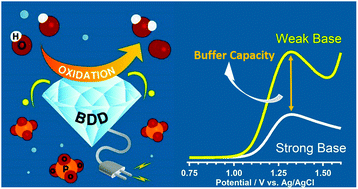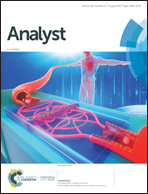Oxidation of hydroxide ions in weak basic solutions using boron-doped diamond electrodes: effect of the buffer capacity†
Abstract
The electrochemical oxidation of hydroxide ions using boron-doped diamond (BDD) electrodes in weak basic solutions was examined. Using simple linear sweep voltammetry (LSV), a well-shaped peak originating from the oxidation of hydroxide ions involving a CE mechanism was observed at ∼1.30 V versus a Ag/AgCl reference electrode in 20 mM H3PO4 solutions with hydroxide ion concentrations ranging from 0.1 to 10 mM. Compared to a NaOH solution with the same hydroxide ion concentration, the peak current in the phosphate solution was found to be higher due to the buffering capability of the phosphate solution, which maintains the hydroxide ion concentration, making it possible to provide more hydroxide ions to the surface of the electrode. The peak was found to depend not only on the hydroxide ion concentration, but also on the phosphate concentration, confirming that the origin of the peak was due to oxidation of the hydroxide ions enhanced by the buffering capability of the weak basic solution. These results further promote the use of BDD electrodes for measuring hydroxide ion concentration, and offer the possibility of directly measuring the buffer capacity of a solution.



 Please wait while we load your content...
Please wait while we load your content...